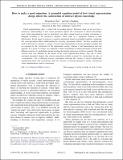How to make a good animation: A grounded cognition model of how visual representation design affects the construction of abstract physics knowledge
Author(s)
Chen, Zhongzhou; Gladding, Gary
DownloadChen-2014-How to make a good animation.pdf (2.280Mb)
PUBLISHER_POLICY
Publisher Policy
Article is made available in accordance with the publisher's policy and may be subject to US copyright law. Please refer to the publisher's site for terms of use.
Terms of use
Metadata
Show full item recordAbstract
Visual representations play a critical role in teaching physics. However, since we do not have a satisfactory understanding of how visual perception impacts the construction of abstract knowledge, most visual representations used in instructions are either created based on existing conventions or designed according to the instructor’s intuition, which leads to a significant variance in their effectiveness. In this paper we propose a cognitive mechanism based on grounded cognition, suggesting that visual perception affects understanding by activating “perceptual symbols”: the basic cognitive unit used by the brain to construct a concept. A good visual representation activates perceptual symbols that are essential for the construction of the represented concept, whereas a bad representation does the opposite. As a proof of concept, we conducted a clinical experiment in which participants received three different versions of a multimedia tutorial teaching the integral expression of electric potential. The three versions were only different by the details of the visual representation design, only one of which contained perceptual features that activate perceptual symbols essential for constructing the idea of “accumulation.” On a following post-test, participants receiving this version of tutorial significantly outperformed those who received the other two versions of tutorials designed to mimic conventional visual representations used in classrooms.
Date issued
2014-04Department
Massachusetts Institute of Technology. Department of PhysicsJournal
Physical Review Special Topics - Physics Education Research
Publisher
American Physical Society
Citation
Chen, Zhongzhou, and Gary Gladding. “How to Make a Good Animation: A Grounded Cognition Model of How Visual Representation Design Affects the Construction of Abstract Physics Knowledge.” Physical Review Special Topics - Physics Education Research 10, no. 1 (April 2014).
Version: Final published version
ISSN
1554-9178